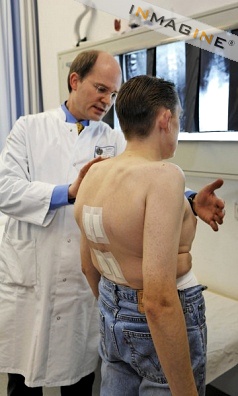 This month, we honor the men in our lives on Father’s Day June 17, 2012 and also in celebrating National Men’s Health Month. This is a good time to raise awareness about health issues that are male gender specific, but also those diseases that are not. Osteoporosis is a prime example. This “silent disease” is usually asymptomatic until a fracture occurs, and is generally assumed to be strictly a “woman’s disease”. While it is true that most postmenopausal women experience rapid loss of bone density, by age 65 or 70 both genders are losing bone mass at exactly the same rate. The National Osteoporosis Foundation estimates that about 2 million American men already have the disease, and another 12 million are at risk for it. In fact, more men over 50 will suffer a fracture than will contract prostate cancer; an estimated 80,000 of those will be hip fractures. Men have a 30% mortality rate following this type of fracture, with many of those dying within a year of the trauma. Mortality rates and incidence of the disease could be greatly reduced with early diagnosis and treatment.
This month, we honor the men in our lives on Father’s Day June 17, 2012 and also in celebrating National Men’s Health Month. This is a good time to raise awareness about health issues that are male gender specific, but also those diseases that are not. Osteoporosis is a prime example. This “silent disease” is usually asymptomatic until a fracture occurs, and is generally assumed to be strictly a “woman’s disease”. While it is true that most postmenopausal women experience rapid loss of bone density, by age 65 or 70 both genders are losing bone mass at exactly the same rate. The National Osteoporosis Foundation estimates that about 2 million American men already have the disease, and another 12 million are at risk for it. In fact, more men over 50 will suffer a fracture than will contract prostate cancer; an estimated 80,000 of those will be hip fractures. Men have a 30% mortality rate following this type of fracture, with many of those dying within a year of the trauma. Mortality rates and incidence of the disease could be greatly reduced with early diagnosis and treatment.
Male osteoporosis is primarily an age-related syndrome with one or more secondary underlying causes, the most common being: smoking, excessive alcohol consumption, gastrointestinal disease, low testosterone and glucocorticoid and immuno-supressive drug intake. As with women, a Bone Mass Density (BMD) test is commonly used to detect presence of the disease. However, men often delay testing until they are either in severe pain or post-fracture, whereas postmenopausal women are routinely advised to be tested. As the “graying” of America accelerates, the incidence of male osteoporosis is likely to rise and attitudes towards testing will have to change. BMD testing guidelines set by the World Health Organization (WHO), were originally designed for women, and as such may not be as accurate for male patients and will have to be revised.
The goal of any osteoporosis treatment plan is the prevention of further bone loss. They include prescribing calcium, Vitamin D supplements, and/or medications such as Fosamax and Actonel that have been approved for male patients. These medications can reduce the risk of fractures by almost 50% within a year’s time. Of equal importance is targeted, consistent physical therapy, concentrating first on any pain management, and then on returning the patient to a healthy lifestyle. PT for osteoporosis centers on weight-bearing exercises and the use of adaptive equipment such as canes and walkers. As recovery progresses, therapists may suggest adding Tai Chi, Yoga and Pilates to daily routines. These activities can defer further bone loss, increase muscle strength, improve coordination and balance, and reduce the risk of reinjury. The Surgeon General advocates 30 minutes of brisk walking a day combined with twice a week resistance training. In addition, certain impact sport can increase bone density, especially running/jogging, tennis, inline skating or cross country skiing, provided the disease is not at an advanced stage. With increased patient and healthcare professionals’ education, proper testing, and lifestyle changes, osteoporosis need no longer be a “silent killer” of men.
If you are a Physical Therapist looking to work with osteoporosis patients, or any other specialty contact Centra Healthcare Solutions at 800 535 0076 and let us assist you in doing what you to do best…helping others.